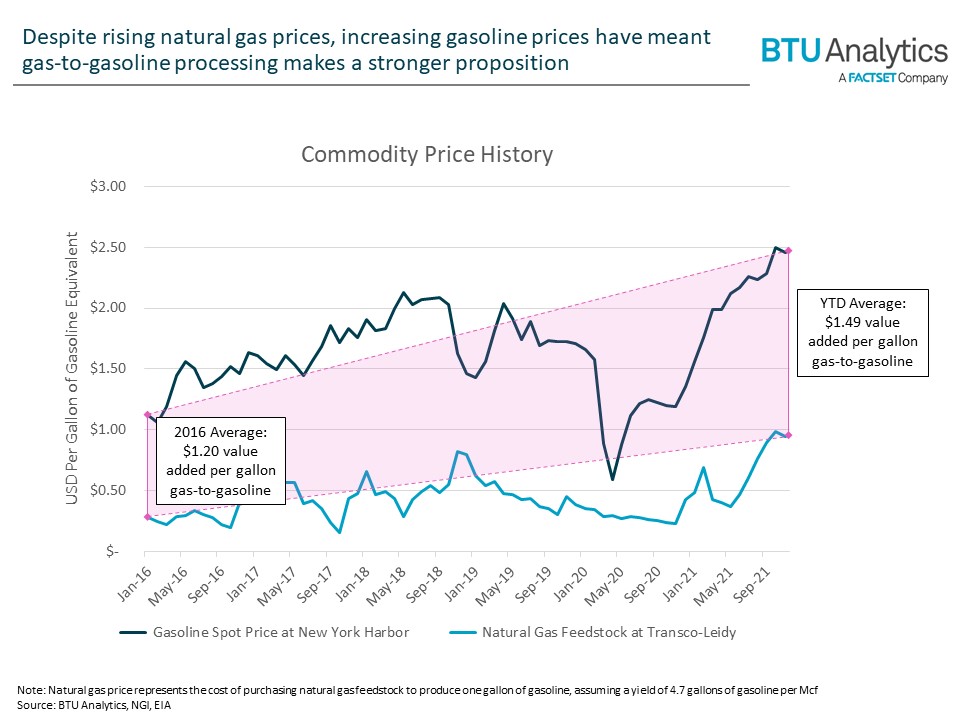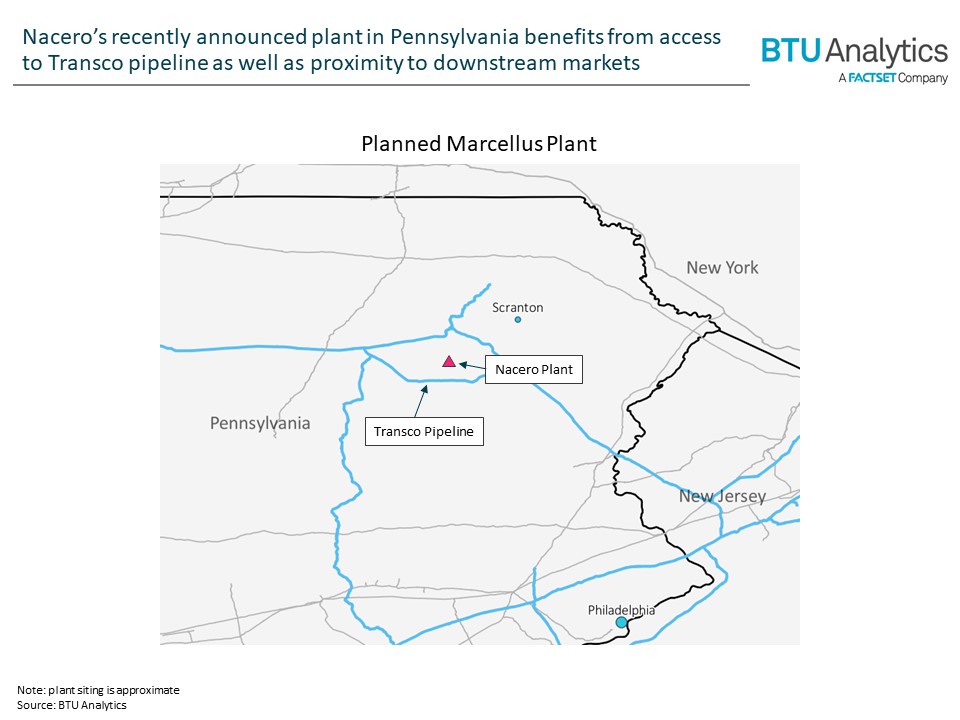Last month, energy start-up Nacero announced plans to develop a $6B gas-to-gasoline plant in Newport Township, Pennsylvania with capacity to produce 100,000 b/d of gasoline. This is just one of three plants in development by Nacero, all of similar scale, which will be the first of their kind in the US. The firm has stated their plan to eventually buildout nine gas-to-gasoline plants across the US. Though the technology of converting natural gas into liquid fuels is not new, rising oil prices and regional dynamics have renewed interest in developing gas to gasoline projects. For today’s Energy Market Insight, BTU Analytics looks at the fundamentals motivating Nacero’s Pennsylvania project and how it could provide an alternative solution to grow production out of a pipeline constrained area.

Despite natural gas prices hitting multi-year highs in 2021, the chart above illustrates that the value-add from processing gas into gasoline has increased. BTU modeled a 4.7 gallon net yield of gasoline from each Mcf of natural gas feedstock, bringing the cost of feedstock to below $1 per gallon of finished product. With this conversion taken into account, the rise of gasoline prices has outstripped the rise in natural gas over the last 5 years. So far in 2021, this has equated to a $1.49 per gallon margin between gasoline prices and feedstock costs, 24% higher than the same measure in 2016.

Sited in Newport Township, Nacero’s planned Pennsylvania complex will sit near the Transco Pipeline at the edge of the Marcellus shale play, where Transco-Leidy basis has averaged $0.61 below Henry Hub since the start of 2019. Gas production in the Northeast has long been infrastructure constrained, with limited capacity driving down basis. In addition to the abundance of cheap gas, ready access to downstream markets in New York and New Jersey was likely deciding a factor in siting this plant.
Nacero has not disclosed the amount of natural gas to be consumed at this facility, but a proxy can be found in existing methanol plants. The TIGAS process which Nacero has licensed from Haldor Topsoe works by first converting natural gas into methanol and then converting the methanol to gasoline. Nacero plans to run six of Topsoe’s SynCOR methanol trains, for a total capacity of 30,000 Mt/d of methanol production. In effect, this will make Nacero’s gas-to-gasoline plants the largest methanol plants in the US, with five times the capacity of the largest current plant. A 2019 analysis by the EIA estimated that the Natgasoline methanol plant in Beaumont, Texas consumed 150 MMcf/d when running at or above its nameplate capacity of 5,000 Mt/d. BTU independently analyzed gas deliveries to the Methanex complex in Geismer, Louisiana and estimated that the plant takes in 174 MMcf/d to support its 6,000 Mt/d capacity. Using these plants for reference, a 30,000 Mt/d facility operating at similarly high utilization would be modeled to consume between 870 and 900 MMcf/d.
While it remains to be seen whether Nacero will succeed in building its fleet of gas-to-gasoline plants, or whether these plants will be economical once completed, an additional 900 MMcf/d of gas demand would represent a substantial shake-up in the regional balance of Northeast Appalachia. As mentioned above, growth of production in the region has been long tamped down by a lack of sufficient takeaway infrastructure. New pipelines and expansion projects have proven politically difficult in the region. Beyond the Leidy expansion in service next month and the potential completion of Mountain Valley Pipeline in 2022, no further pipeline infrastructure is expected to exit the region. For in depth analysis, of Mountain Valley Pipelines risks to development see BTU Analytics November Gas Bas Outlook.

As seen in the chart above, E&P operators have moderated development to meet a finite amount of demand which can effectively be serviced through the existing pipeline network. A gas-to-gasoline plant on the scale Nacero proposes could allow for up to a 7% jump in regional production.









